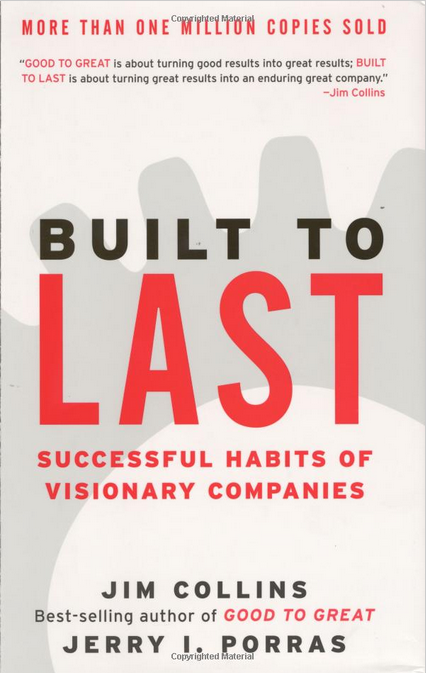‘Built To Last’ by Jim Collins & Jerry Porras

Feel free to check out my highlights after reading Built To Last.
Some excerpts:
- “We suggest that the continual stream of great products and services from highly visionary companies stems from them being outstanding organizations, not the other way around. Keep in mind that all products, services, and great ideas, no matter how visionary, eventually become obsolete. But a visionary company does not necessarily become obsolete. Similarly, all leaders, no matter how charismatic or visionary, eventually die. But a visionary company does not necessarily die.”
- “A detailed pair by pair analysis showed that he visionary companies have generally been more ideologically driven and less purely profit-driven than the comparison companies in 17 out of 18 pairs. This is one of the clearest differences we found between the visionary companies and comparison companies. Of course we’re not saying that visionary companies have been uninterested in profitability or long term shareholder wealth. Yes, they pursue profits. They do both.”
- “Core ideology in a visionary company works hand in hand with a relentless drive for progress that impels change and forward movement in all that is not part of the core ideology. The drive for progress arises from a deep human urge- to explore, to create, to discover, to achieve, to change, to improve.”
- “The single most important point to take away form this book is the critical importance of creating tangible mechanisms aligned to preserve the core and stimulate progress. This the the essence of clock building.”
- “The specific methods of preserving the core and stimulating progress fall into 5 categories:
- BHAGs – Big Hairy Audacious Goals
- Cult Like Cultures
- Try a lot of stuff and keep what works
- Home grown management
- Good enough never is
- “These provocative examples led us to a second type of progress (the first was BHAGs) stimulated by the visionary companies to greater degree than the comparison companies: evolutionary progress… We like to describe the evolutionary process as ‘Branching and Pruning.’ The idea is simple: If you add enough branches to a tree (variation) and intelligently prune the deadwood (selection), then you’ll likely evolve into a collection of healthy branches well positioned to prosper in an ever-changing environment.”
- Willard Marriott Sr. said: “Discipline is the greatest thing in the world. Where there is no discipline there is no character. And without character, there is no progress…” “Our research findings clearly support the concept of continuous improvement, but not as a program or management fad. In a visionary company, it is an institutionalized habit-a disciplined way of life-ingrained into the fabric of the organization and reinforced by tangible mechanisms that create discontent with the status quo…It means long-term investments for the future; it means new investment in the development of employees, it means adoption of new ideas and technologies. In short, it means doing everything possible to make the company stronger tomorrow than it is today.”
- “Managers of visionary companies simply do not accept the proposition that they must choose between short-term performance or long-term success. They build first and foremost for the long term while simultaneously holding themselves to highly demanding short-term standards.”